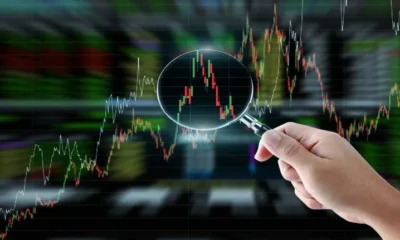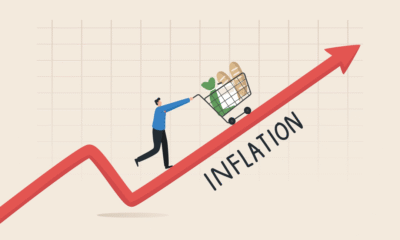Finance
Top 5 Recession-Proof Stocks to Invest in 2025

Introduction to Recession-Proof Investing
Recession-proof investing is a financial strategy that focuses on selecting stocks capable of withstanding economic downturns while maintaining stability and growth potential. During periods of economic challenge, including recessions, market fluctuations can lead to significant losses for investors who are unaware of the resilient nature of certain sectors and stocks. Therefore, understanding the dynamics surrounding recession-proof investments is essential for any investor looking to safeguard their financial portfolio.
Historically, recessions are characterized by decreased consumer spending, rising unemployment, and a general decline in economic activity. As a result, investors tend to re-evaluate their strategies, often opting for stocks that are more likely to weather the storm of economic uncertainty. Certain sectors, such as consumer staples, healthcare, and utilities, exhibit resilience during recessions because they provide essential products and services that consumers need regardless of the economic climate. Investing in these recession-resistant stocks can be a prudent way to mitigate risks associated with market volatility.
Furthermore, the impact of a recession on investment strategies cannot be underestimated. Many investors often panic during downturns and liquidate their holdings, potentially realizing losses that could have been avoided with a more measured approach. By identifying stocks that possess a history of stability and resilience, investors can better position themselves to navigate through difficult times. This strategic allocation can enhance portfolio performance, as recession-proof stocks typically experience less volatility compared to their cyclical counterparts.
In summary, recognizing the importance of recession-proof investing allows investors to make informed decisions that can lead to long-term financial security amidst economic challenges. As we delve into the specific stocks that exemplify this strategy, it is essential to consider their resilience in the face of economic adversity, thereby setting the foundation for a more stable investment approach.
Understanding Recession-Proof Stocks
Recession-proof stocks refer to shares of companies that tend to remain stable or continue to generate revenue even during economic downturns. These stocks are typically associated with sectors that provide essential goods and services, which are critical to consumer needs regardless of the economic climate. Understanding the characteristics that define recession-resistant companies can aid investors in making informed decisions, particularly in turbulent financial periods.
One of the primary attributes that distinguish recession-proof stocks is their ability to maintain consistent revenue streams. Companies that operate in industries such as utilities, healthcare, and consumer staples often exhibit resilience during recessional phases. These sectors usually cater to fundamental consumer requirements, making it less likely that their revenues will experience significant fluctuations in demand. For instance, people will continue to seek medical care and purchase groceries, even when tightening their budgets.
In addition to steady revenue generation, strong balance sheets are another hallmark of recession-resistant companies. Firms that boast low levels of debt, healthy cash reserves, and robust profit margins are typically better positioned to weather economic downturns. This financial stability allows them to absorb unexpected shocks and invest in opportunities to enhance their performance post-recession. Such characteristics not only fortify their market position but also instill confidence among investors.
Moreover, companies that offer essential services are often deemed recession-proof. These services may include products that consumers view as necessities rather than luxuries, such as inexpensive food options, personal hygiene items, or affordable utilities. These essentials retain demand regardless of economic conditions, allowing these companies to navigate through downturns with greater ease. Overall, the characteristics of resilience, financial strength, and essential service provision collectively create a solid foundation from which recession-proof stocks emerge.
Sector Analysis: Where to Look for Resilience
In times of economic uncertainty, certain sectors consistently demonstrate resilience, making them viable options for investors seeking stability. Historical data reveals that sectors such as consumer staples, healthcare, and utilities often perform better than others during recessions. These industries possess characteristics that allow them to maintain steadier cash flows, even in challenging economic environments.
Consumer staples represent goods that people need regardless of economic downturns, including food, beverages, and household products. This sector typically experiences consistent demand, as consumers prioritize essential purchases over discretionary spending. Moreover, companies within this realm tend to establish strong brand loyalty, allowing them to navigate economic pressures more effectively than non-essential goods manufacturers. Notable enterprises in this sector often maintain solid dividend payouts, offering additional security to investors.
The healthcare sector, encompassing pharmaceuticals, biotechnology, and medical services, also remains robust during recessions. Regardless of the economic climate, individuals still require medical attention, medications, and healthcare services. The increasing focus on health and wellness further solidifies the relevance of healthcare investments. Historical trends have shown that healthcare stocks often exhibit lower volatility compared to those in more cyclical industries, contributing to their appeal as a recession-proof investment option.
Utilities, comprising essential services like water, electricity, and natural gas, offer another layer of investment stability. These companies typically operate under regulated environments, which can mitigate risks associated with market fluctuations. During downturns, demand for utility services remains stable, as consumers continue to utilize essential resources, even as they curtail discretionary spending. This characteristic allows utility stocks to maintain reliable revenue streams, enhancing their resilience against recessionary pressures.
Analyzing these sectors provides investors with a clearer understanding of where to seek stability during market downturns. By recognizing the historical performance patterns associated with consumer staples, healthcare, and utilities, investors can strategically position themselves with potentially recession-proof stocks in anticipation of 2025 and beyond.
Stock #1: Company Overview and Financial Health
The first identified recession-proof stock is a prominent player in the consumer staples sector, known for its resilient business model and consistent financial performance. Established over two decades ago, this company has positioned itself as a leading provider of essential goods, catering to the everyday needs of consumers. Its diverse product offerings range from food and beverages to personal care items, ensuring a steady demand even in challenging economic climates.
One of the key strengths of this company is its robust business model, which emphasizes efficiency in supply chain management and strategic market penetration. By maintaining strong relationships with suppliers and employing innovative inventory management techniques, the company effectively minimizes costs, thereby enhancing profit margins. This operational efficiency allows it to pass potential savings on to consumers, making its products attractive even when budgets are tight.
Recent financial performance has demonstrated the company’s resilience. Despite economic pressures, its revenue streams remain stable, underpinned by consistent demand for essential goods. In the last fiscal year, the company reported a steady increase in revenue, attributed to its agile response to market changes and the introduction of new products tailored to consumer preferences. Furthermore, its focus on e-commerce has opened additional avenues for growth, allowing it to reach customers directly and reduce reliance on traditional retail channels.
To maintain stability during economic downturns, the company employs several strategies, such as strategic pricing and maintaining a strong balance sheet. The company’s commitment to maintaining a healthy cash reserve has enabled it to navigate market volatility without compromising on quality or service. Additionally, the ongoing investment in research and development ensures that the company continues to adapt to shifting consumer needs, reinforcing its position as a reliable choice for investors seeking recession-proof stocks.
Stock #2: Competitive Advantage and Market Position
As we explore the second stock in our list of recession-proof stocks for 2025, it is essential to focus on the competitive advantages that bolster its market position. This particular company has made significant strides in establishing a robust presence within its industry, thanks to its strategic approach to product development and customer engagement. One of the defining features of this stock is its strong brand loyalty. The company has cultivated a loyal customer base through consistent quality, innovative offerings, and exceptional customer service, which are critical components in retaining market share during economic downturns.
Furthermore, the company offers a diversified product line that caters to a wide range of consumer needs. This diversification not only minimizes risks associated with market fluctuations but also allows the company to capitalize on emerging trends. For instance, its forward-thinking approach to technology integration enhances operational efficiency and customer experience. By leveraging technology, the company can streamline processes and offer personalized services, solidifying its competitive edge in a saturated market.
The unique business strategies employed by this stock also play a pivotal role in its stability. Fostering strategic partnerships and alliances enables the company to augment its resources and expand its reach. For instance, collaborations with other industry leaders position it favorably against competitors, enhancing its market standing. Additionally, the commitment to sustainability not only appeals to socially conscious consumers but also aligns with global standards, boosting its reputation further.
Overall, this stock’s competitive advantages and steadfast market position highlight its resilience against economic uncertainties. By focusing on product excellence, customer loyalty, and innovative strategies, it emerges as a compelling choice for investors seeking stability amid potential economic challenges.
Stock #3: Historical Performance During Recessions
When evaluating potential investments, particularly during uncertain economic climates, analyzing historical performance during recessions is critical. The third stock in our lineup has exhibited commendable resilience in previous downturns, providing a reassuring prospect for investors seeking stability. This stock has consistently demonstrated its ability to weather economic storms, making it an appealing option for those concerned about market volatility.
To examine this stock’s historical performance, it is imperative to reference specific recessions over the last few decades. For instance, during the 2008 financial crisis, this stock maintained a relatively stable price trajectory compared to the broader market, which experienced significant declines. Historical data illustrates that the stock’s declines were limited, often rebounding quickly once economic conditions began to stabilize. Such behavior is indicative of strong fundamentals and a loyal customer base that supports revenue generation even in tough times.
Charts depicting the stock’s performance against major market indices during previous recessionary periods further underscore its defensive qualities. In times of economic contraction, sectors such as consumer staples or healthcare tend to perform well, and this stock falls into such a category. By offering essential products or services, it has succeeded in preserving investor wealth when other stocks faced substantial losses.
Moreover, comparing this stock to its contemporaries reveals a consistent pattern of relative outperformance. Data shows that while many stocks struggled to regain lost ground in post-recession recoveries, this stock often exceeded pre-recession price levels, illustrating its enduring appeal to investors. This historical resilience, paired with an attractive dividend yield, reinforces why this stock stands out as a prudent choice for investors looking to secure their portfolios against potential economic downturns.
Stock #4: Dividend Stability and Growth Potential
When considering recession-proof stocks for investment, one significant aspect is the consistency of dividend payments, particularly during economic downturns. The fourth stock in our list demonstrates impressive stability and growth potential through its reliable dividend policy. In times of financial uncertainty, a dependable dividend serves as a critical buffer for investors, providing a continuous income stream even when market volatility looms large.
This particular stock has a commendable history of maintaining and increasing its dividends over the years. It has managed to uphold its dividend payments through challenging economic conditions, reflecting not only its strong operational performance but also its commitment to returning value to shareholders. This historical stability signifies a well-managed company that prioritizes shareholder interests, particularly during times of recession when investors often pivot toward stocks that offer stable returns.
Furthermore, the potential for future growth adds to the attractiveness of this stock. Analysts project that the company’s revenue streams are likely to strengthen, even amidst macroeconomic pressures. Its resilient business model, combined with strategic initiatives aimed at enhancing productivity and market share, positions the company favorably for sustained growth. As such, investors can expect not only consistent dividend payments but also the potential for increases in dividends as profitability expands.
Overall, this stock showcases the critical balance between reliable dividend payouts and robust growth potential. As investors seek refuge during economic downturns, those drawn to the assurance of dividends will find this stock appealing, reinforcing its status as a worthy contender in a recession-proof portfolio. The integration of dividend stability with growth prospects solidifies its position among the top investment choices for 2025.
Stock #5: Future Outlook and Investment Considerations
Stock #5, a prominent player in the defensive sector, continues to demonstrate resilience amid economic uncertainty. As we look towards 2025, this stock shows promising growth potential based on its historical performance and strategic initiatives. The company’s commitment to innovation, particularly through the expansion of its product lines, suggests a robust ability to adapt to changing market demands while maintaining a steady revenue stream.
One of the key factors underpinning the future outlook of this stock is its diversified portfolio, which allows it to mitigate risks associated with economic downturns effectively. The management has laid out a comprehensive strategy that focuses on enhancing operational efficiencies and tapping into new markets. This proactive approach not only aims to sustain their competitive edge but also signals to investors that the company is well-positioned for long-term growth even in turbulent times.
Nevertheless, potential investors should remain cognizant of the challenges that may lie ahead. The highly competitive nature of the industry, along with rising raw material costs and evolving regulatory landscapes, may pose obstacles. It’s crucial for the company to navigate these hurdles successfully to maintain its reputation as a reliable investment. Additionally, fluctuations in consumer demand can impact earnings, making it imperative for the company to stay attuned to market trends.
In assessing whether this stock aligns with investment goals, potential investors should consider their risk tolerance and investment horizons. Overall, Stock #5 presents a compelling case as a recession-proof stock, but due diligence is essential. With informed insight into its strategic moves and potential challenges, investors can make better choices that align with their financial objectives in the years ahead.
Conclusion: Making Informed Investment Choices
As we navigate the complexities of the financial landscape, particularly during economic downturns, the importance of adopting a strategic approach to investing cannot be overstated. In the preceding sections, we discussed five recession-proof stocks that have demonstrated resilience and stability even in challenging economic climates. These stocks not only offer a safeguard for investors but also present opportunities for growth, even when the market faces adversity.
Diversification emerges as a key strategy in our discussion. By incorporating a range of recession-proof stocks into your investment portfolio, you can mitigate risks associated with market volatility. Each of the highlighted stocks presents unique strengths, catering to varying investor preferences, from essential consumer goods to healthcare and utilities. These sectors have historically exhibited a level of consistency during economic downturns, making them prudent choices for capital preservation.
Investors should remain vigilant and proactive in evaluating their stock selections, especially in times of economic uncertainty. Regular portfolio assessments allow one to identify underperforming assets and adjust strategies accordingly. Moreover, considering macroeconomic indicators and industry trends can offer valuable insights into the performance potential of recession-resistant stocks. Keeping abreast of these factors ensures that investors are well-informed and poised to make timely decisions that align with their financial goals.
In conclusion, the key takeaway from our exploration of recession-proof stocks is the need for a well-rounded investment strategy. By focusing on stocks that can withstand economic hardships, investors can build a more resilient portfolio that stands the test of time. Though uncertainty is a constant in economic cycles, informed investment choices can provide a pathway to sustained financial health and stability in 2025 and beyond.
Investing
Global Investor Outflows from U.S. Stocks & Dollar

In a shift that is sending ripples across financial markets, institutional investors around the world are pulling back from U.S. equities and reducing exposure to the U.S. dollar, signaling a significant change in sentiment toward American assets. According to the latest Bank of America Global Fund Manager Survey, global investors are now the most underweight on U.S. stocks in more than two decades, with the dollar facing similar skepticism as a long-term safe-haven asset. This transition is being fueled by multiple converging factors, including geopolitical instability, growing U.S. fiscal deficits, trade tensions, and an increasingly favorable investment climate in Europe and select emerging markets. For investors, economists, and policymakers alike, this trend represents a rebalancing of global capital flows that could reshape market dynamics in the months ahead.
Investor Sentiment Toward U.S. Markets Hits Multi-Year Lows
The Bank of America survey, considered a key barometer of global institutional sentiment, reveals that fund managers have turned heavily underweight on U.S. stocks and the dollar, preferring instead to rotate their portfolios into European and Asian equities. The survey showed that 36% of participants are now net underweight U.S. equities—the highest level since 2003. At the same time, positioning on the dollar turned net negative for the first time in over five years, with investors citing mounting fiscal concerns, valuation extremes, and weakening macroeconomic indicators.
The U.S. equity market, especially the tech-heavy NASDAQ, has experienced an extraordinary bull run over the last several years. But now, investors are questioning the sustainability of elevated valuations, particularly as economic growth slows, earnings forecasts are revised downward, and inflation remains persistently above target. Many portfolio managers believe the best returns may no longer be found in U.S. assets alone.
Rising U.S. Debt and Fiscal Deficits Raise Red Flags
A key driver of investor caution is the ballooning U.S. fiscal deficit. The Congressional Budget Office (CBO) projects that the U.S. federal deficit will reach over $1.8 trillion this year, driven by increased government spending, rising interest costs, and lower-than-expected tax revenues. The national debt is now projected to exceed 125% of GDP by 2030, raising serious questions about long-term fiscal sustainability.
Investors fear that soaring U.S. debt levels could lead to a loss of confidence in Treasury securities, pushing yields higher and triggering volatility in global credit markets. This concern is magnified by the growing political polarization in Washington, which has led to repeated debt ceiling standoffs and policy gridlock. As a result, some asset managers are choosing to diversify their bond portfolios with sovereign debt from countries like Germany, Canada, and Australia—nations viewed as having stronger fiscal discipline.
Geopolitical Tensions Erode Dollar Safe-Haven Appeal
The traditional role of the U.S. dollar as a global safe-haven currency is also being called into question. With the U.S. now embroiled in rising geopolitical conflicts, including its military engagement in the Middle East and an escalating trade war with China, the perception of the dollar as a “neutral” or stable currency is beginning to fade. Several countries, particularly in the Global South, have voiced frustration over the dominance of the dollar in international trade, and some have even accelerated efforts to settle trade in alternative currencies such as the euro, yuan, or local currency blocs.
In response, central banks in emerging markets are reducing their U.S. dollar reserves and increasing holdings in gold and non-dollar currencies. This trend, while gradual, is gaining momentum and contributing to the dollar’s underperformance against a basket of global currencies. The U.S. dollar index (DXY) has declined by nearly 6% year-to-date, reflecting both diminished investor confidence and a broader reconfiguration of reserve management strategies.
Attractive Valuations Abroad Drive Capital Outflows
While risks in the U.S. are mounting, attractive investment opportunities abroad are also contributing to the outflow of capital from American markets. European equities, particularly in sectors like green energy, luxury goods, and financial services, are seeing renewed interest thanks to relatively low valuations and improving macroeconomic stability. The recent ECB rate cuts and Eurobond discussions have added to optimism about the region’s fiscal and financial integration.
In Asia, countries like India, Indonesia, and Vietnam are emerging as new hotspots for foreign direct investment and equity inflows. These economies offer robust growth prospects, younger demographics, and increasingly tech-driven industries. Additionally, Japan’s bond market is seeing increased institutional buying, as long-term yields rise in response to the Bank of Japan’s policy changes.
This global diversification strategy is not just about seeking higher returns—it’s also about managing risk. Investors are increasingly looking to balance their portfolios geographically, reducing dependence on any single region and hedging against macroeconomic shocks that may be specific to the U.S.
Currency Hedging and Diversification as Defensive Strategies
In response to the dollar’s volatility, many fund managers are now engaging in currency hedging strategies to protect their portfolios. Currency ETFs, options, and forward contracts are being used to minimize the downside risk of a weakening dollar. At the same time, global investment funds are ramping up their exposure to non-dollar-denominated assets, including eurozone corporate bonds, emerging market debt, and local-currency sovereign issues.
Moreover, ESG and green bond markets in Europe and Asia are attracting capital due to their alignment with global sustainability goals. These instruments not only offer diversification but also align with broader institutional mandates on responsible investing.
Implications for U.S. Markets and Monetary Policy
The capital flight from U.S. assets could have significant implications for American markets. A persistent decline in foreign demand for U.S. Treasuries may force the Federal Reserve to intervene more frequently in the bond market to maintain liquidity and control yields. At the same time, a weaker dollar could contribute to imported inflation, complicating the Fed’s efforts to bring core inflation back within its target range.
On the equities side, if investor outflows persist, U.S. companies may face higher capital costs and declining valuations, particularly in sectors that rely heavily on foreign investment or exports. Domestic pension funds and institutional investors may need to fill the gap left by global investors, which could further alter asset allocation strategies and influence corporate financing decisions.
A New Era of Global Capital Rotation
The growing shift away from U.S. stocks and the dollar signals the beginning of a new era in global investing, one defined by diversification, geopolitical hedging, and currency rebalancing. While the U.S. remains a central player in global finance, the days of unquestioned dominance are beginning to fade, as investors embrace a more nuanced and distributed view of risk and opportunity.
For market participants, staying agile in this environment means tracking global fund flows, monitoring geopolitical developments, and reassessing the traditional U.S.-centric portfolio model. As capital continues to flow into European and Asian markets, the future of global finance is being rewritten—and those who adapt early may find themselves ahead of the curve.
Finance and Economy
France Pushes Eurozone Toward Joint Eurobond Issuance

In a bold move that could redefine the financial architecture of the European Union, France has renewed its push for the issuance of joint eurozone debt instruments – commonly referred to as Eurobonds – as a way to strengthen the euro on the global stage. As the EU prepares for its upcoming summit on June 26-27, the proposal is once again stirring heated debate among member nations. French officials argue that a shared debt mechanism is essential not only for financial resilience but also for elevating the euro’s standing as a credible alternative to the U.S. dollar. While the idea garners support from key institutions like the IMF and the ECB, resistance from fiscally conservative member states continues to block consensus. This article explores the implications of France’s proposal, the potential benefits and challenges of Eurobond issuance, and the evolving role of the euro in a multipolar financial world.
France’s Strategic Case for Eurobonds
French President Emmanuel Macron and Finance Minister Bruno Le Maire have long been advocates for deeper EU financial integration. According to them, Eurobonds would represent a tangible step toward fiscal solidarity and monetary cohesion, allowing member nations to borrow at collectively favorable rates while demonstrating political unity. The latest push comes at a time when the European economy is facing several headwinds: slowing growth, fragmented recovery across member states, and heightened global financial volatility triggered by geopolitical conflicts and energy insecurity. Macron has reiterated that a common debt tool is essential for financing major EU-wide projects such as green energy transition, digital infrastructure, and military defense.
From a strategic standpoint, France views Eurobonds as more than just a financial mechanism – they are a symbol of EU credibility and resilience. By pooling risk and aligning borrowing capacity, the eurozone could present a united front in capital markets, reducing the vulnerability of weaker economies and improving the euro’s attractiveness to foreign investors.
The Euro’s Current Global Standing and Its Challenges
Despite being the world’s second most-used currency, the euro still lags far behind the U.S. dollar in terms of global reserve share, trade settlement, and safe-haven preference. Analysts point out that one of the primary reasons for this is the fragmented nature of the eurozone bond market. Each country issues its own sovereign debt, leading to a lack of a single, risk-free eurozone bond benchmark – unlike U.S. Treasuries, which offer deep liquidity and low risk.
France’s proposal seeks to address this imbalance. A unified Eurobond market could create a highly liquid, stable, and scalable financial product that would attract central banks, pension funds, and sovereign wealth investors. Over time, this could shift more global reserves into euros, boosting the currency’s influence in global trade and finance.
Institutional Support: IMF, ECB, and Market Participants
Key international organizations have thrown their weight behind the idea. The International Monetary Fund (IMF) has suggested that Eurobonds could enhance the EU’s fiscal capacity and crisis response agility. Meanwhile, European Central Bank (ECB) officials, including President Christine Lagarde, have hinted that deeper fiscal integration is necessary for the euro to realize its full potential.
Financial market participants have also shown interest. Asset managers argue that Eurobonds could become a cornerstone of fixed-income portfolios, particularly for investors looking to diversify away from dollar-denominated assets. Some analysts compare the opportunity to the creation of the U.S. Treasury market in the post-war era, which laid the groundwork for the dollar’s global dominance.
Opposition from the Frugal Four and Risk-Sharing Concerns
Despite France’s enthusiasm and institutional support, significant opposition persists from fiscally conservative EU nations, notably Germany, Austria, the Netherlands, and Finland—often dubbed the “Frugal Four.” These countries argue that shared debt would penalize responsible fiscal behavior and open the door to moral hazard, where weaker economies might overborrow under the protection of joint guarantees.
German officials have also cited constitutional constraints and public opposition to any perceived “debt mutualization.” Instead, they advocate for reforms at the national level, more stringent budget controls, and the use of existing mechanisms like the European Stability Mechanism (ESM) for crisis funding.
This divide continues to stall formal negotiations. At the heart of the debate is the question of trust and fiscal governance, as many northern states remain skeptical about the long-term commitment of their southern counterparts to austerity and budget discipline.
Implications for Financial Markets and Investors
If approved, Eurobonds would be a game-changer for European capital markets. They would offer a new safe asset class, potentially rivaling U.S. Treasuries in size and reliability over the long term. For the European banking system, Eurobonds could provide high-quality collateral and improve liquidity conditions, especially for cross-border lending.
Investors are closely monitoring the situation. If the EU takes concrete steps toward joint bond issuance, bond yields across peripheral economies like Italy, Spain, and Greece could compress further, as risk premia shrink in anticipation of shared guarantees. Simultaneously, euro-denominated assets may see a surge in foreign inflows, especially from central banks seeking to rebalance reserve portfolios.
Strengthening the Euro’s Role in a Multipolar World
The geopolitical landscape is increasingly defined by multipolarity, with China, Russia, and the U.S. competing for influence in trade, finance, and security. In this context, the eurozone faces a historic opportunity to carve out a more assertive role. Strengthening the euro through fiscal and capital market integration is seen as essential to counterbalance the dollar’s dominance and reduce reliance on U.S.-led financial infrastructure.
Eurobonds could serve as a financial pillar in this transition. As global investors seek alternatives in a fragmented world economy, the euro’s rise as a stable, investable, and liquid currency backed by joint instruments could bolster its credibility and utility.
A Defining Moment for European Unity
France’s push for Eurobonds is more than just a fiscal proposal – it is a call for political and financial unity in a time of global uncertainty. While the road to consensus is steep, the growing support from institutions, investors, and southern EU members suggests that momentum is building. The upcoming EU summit will be a crucial test of the bloc’s ability to move beyond national interests and toward a shared financial future.
If successful, Eurobond issuance could redefine the eurozone’s role in the global economy, offering new tools for crisis response, economic development, and financial competitiveness. For investors and policymakers alike, this moment marks a critical juncture – either Europe seizes the opportunity to lead, or it risks remaining a secondary player in a rapidly evolving financial world.
Finance and Economy
Oil Price Spike as Middle East Conflict Deepens: A Global Market Wake-Up Call

The financial world is once again on high alert as escalating tensions in the Middle East have triggered a sharp surge in global oil prices, sending shockwaves through equity, commodity, and currency markets alike. With the U.S. reportedly striking Iran’s nuclear sites, Brent crude surged over 18%, nearing $80 per barrel in a matter of hours. The sudden volatility reignited fears of a potential $100 oil scenario, reminiscent of past geopolitical flashpoints that deeply impacted global supply chains, inflation expectations, and central bank policy stances. This article delves into the causes, consequences, and global financial implications of this emerging crisis.
The Trigger: U.S. Strikes on Iran’s Nuclear Infrastructure
On June 21, 2025, international news outlets confirmed that U.S. military forces had targeted Iranian nuclear facilities in what they described as a “pre-emptive defensive measure.” While the full extent of the damage is still being assessed, the attack has clearly escalated tensions in an already volatile region. The Middle East, being a vital hub for global oil production and shipping, plays a significant role in maintaining supply stability. Iran, which controls access to the Strait of Hormuz – a key chokepoint through which nearly 20% of the world’s oil supply passes—responded with threats to close the strait and intensify its military posturing. This heightened the risk premium in energy markets virtually overnight.
Oil Prices React Swiftly to Geopolitical Instability
Crude oil, especially Brent and West Texas Intermediate (WTI), reacted with extreme sensitivity to the developments. Brent crude jumped over 18% within a 24-hour period, while WTI saw a comparable surge. Analysts at Goldman Sachs and JPMorgan warned that if the Strait of Hormuz were to be blocked, prices could surpass $100 per barrel within weeks. The last time the oil market saw such an intense geopolitical premium was during the 2019 drone attacks on Saudi oil facilities. However, the current situation has a more severe undertone due to the involvement of nuclear assets and direct military strikes between two powerful adversaries.
Safe Haven Assets Soar as Risk Appetite Declines
As is common in times of geopolitical crisis, investors flocked to safe-haven assets such as gold, the U.S. dollar, and U.S. Treasuries. Gold climbed above $2,400 per ounce, a level not seen in years, while the U.S. dollar index rose nearly 2% as capital fled emerging markets and riskier assets. Meanwhile, 10-year U.S. Treasury yields fell sharply, reflecting a surge in demand for perceived low-risk instruments. Cryptocurrency markets, particularly Bitcoin, experienced a brief rally as some investors viewed digital assets as alternative stores of value, although that rally quickly reversed amid broader market instability.
Stock Markets Face Broad Sell-Off, Led by Energy-Sensitive Sectors
Equity markets around the globe responded negatively. The S&P 500 and NASDAQ both dropped over 2.5% in intraday trading, led by declines in consumer discretionary, industrials, and airline stocks, which are highly sensitive to fuel price increases. European indices such as the FTSE 100 and DAX also saw steep losses, while Asia-Pacific markets like the Nikkei 225 and Hang Seng Index fell sharply as investors priced in a higher global risk premium. Interestingly, energy stocks provided the only bright spot in an otherwise red sea of market activity, with companies like ExxonMobil and Chevron posting strong gains on expectations of rising revenues.
Inflationary Pressures Could Derail Central Bank Strategies
The surge in oil prices couldn’t have come at a worse time for global central banks. After years of battling inflation through aggressive interest rate hikes, many central banks had only just begun to pause or consider rate cuts in 2025. However, higher energy prices feed directly into inflation, particularly in transport, manufacturing, and agriculture sectors, potentially forcing monetary authorities to reverse their dovish pivot. The European Central Bank (ECB), which had recently initiated its first rate cut in years, may now face pressure to hold off on further easing. Similarly, the Federal Reserve, which had opted to maintain its current rate in the last FOMC meeting, is likely to adopt a more hawkish tone moving forward.
Emerging Markets Bear the Brunt of the Crisis
The fallout from spiking oil prices is especially damaging for emerging markets, which are typically more sensitive to commodity price fluctuations. Countries like India, Turkey, and South Africa, which are major oil importers and have significant current account deficits, saw their currencies depreciate against the dollar. This adds to inflationary pressures and increases the cost of dollar-denominated debt, complicating fiscal and monetary policy responses. Foreign institutional investors also withdrew capital from these markets, adding to equity market stress and further depressing sentiment.
Global Economic Growth at Risk
Economists are revising down global GDP forecasts amid fears that higher oil prices will dampen consumer spending, elevate production costs, and destabilize corporate earnings. According to the IMF, a sustained oil price above $90 could reduce global GDP growth by 0.5% annually, with some regions like Southeast Asia and Sub-Saharan Africa experiencing even greater negative impacts. Supply chains, already recovering from post-pandemic disruptions and trade tensions, now face renewed uncertainty due to potential shipping bottlenecks in the Persian Gulf.
Outlook: What Comes Next for Markets and Policymakers?
Going forward, much depends on how the situation in the Middle East evolves. A de-escalation through diplomatic channels, possibly via UN or EU mediation, could stabilize oil prices and soothe market nerves. On the other hand, if Iran follows through on its threat to block the Strait of Hormuz or retaliates militarily, the crisis could escalate into a full-blown regional conflict with severe repercussions for global trade and energy supply. Policymakers worldwide are monitoring the situation closely, and emergency meetings by OPEC and G20 finance ministers are already being planned. The International Energy Agency (IEA) has also signaled its willingness to release strategic petroleum reserves if needed to calm markets.
The Road Ahead is Uncertain but Manageable
In the face of rising geopolitical tensions and economic uncertainty, investors are advised to adopt a cautious, diversified approach. While markets remain volatile and unpredictable, sound investment principles – such as maintaining a balanced portfolio, avoiding over-leveraged positions, and focusing on long-term fundamentals – remain more relevant than ever. The oil price spike triggered by the U.S.-Iran conflict is a potent reminder of how global politics and finance are deeply intertwined, and why staying informed and agile is critical in today’s interconnected world.
-

 Technology and Finance3 months ago
Technology and Finance3 months agoThe Future of Quantum Computing in Financial Modeling and Trading
-

 Finance3 months ago
Finance3 months agoUSA Market Trends & Global Finance Insights
-
Finance3 months ago
Navigating Retirement in the Gig Economy: Challenges and Solutions
-

 Finance3 months ago
Finance3 months agoNavigating Personal Finance in the Age of Inflation and High Interest Rates
-

 Finance3 months ago
Finance3 months agoTop 10 High-Yield Savings Accounts in the US (2025 Edition)
-

 Investing & Finance3 months ago
Investing & Finance3 months agoFractional Investing: The Path to Wealth Democratization
-

 Finance3 months ago
Finance3 months agoDecentralized Finance (DeFi): Opportunity or Risk? A Deep Dive into the Rise of DeFi Platforms and Their Challenge to Traditional Finance
-

 Personal Finance2 months ago
Personal Finance2 months agoHow Gen Z is Saving Differently Than Millennials




